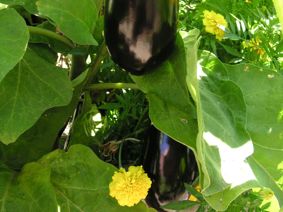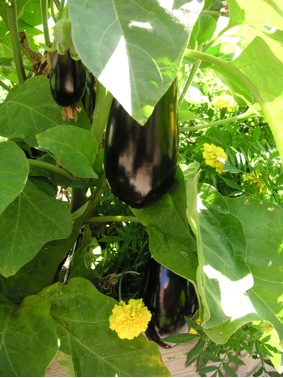
reference-image, l
(post, Caroline Lewis)
We are often asked why we grow vegetables in raised beds. What are the advantages and disadvantages? As one Culinate member put it, “What is really stopping you from growing vegetables just as intensely right in the ground?” Good question, and one I’ll attempt to answer. When I refer to conventional garden methods, I’m not talking about organic vs. non-organic growing. I’m referring to traditional row gardens, in which people till a section of earth, amend the soil, and plant their gardens in rows, with paths to walk on in between. This is how most American farmers have traditionally grown their vegetables, at least in part because they can space their rows to allow tractors, plows, and other machinery access to the crops. There is some confusion over the term “raised beds” because many gardeners grow their vegetables in raised mounds of soil in between paths. Others, such as Larry and I, build containers or frames to hold soil and grow in those. For the sake of simplicity — and because it’s what I know best — the focus of this discussion is on the latter. [%image eggplant float=right width=400 caption="A summer scene from a raised-bed garden."] One farmer and author for whom I have great respect is Eliot Coleman, who wrote The New Organic Grower. It’s a wonderful book, but I have no desire to garden as Coleman does. His garden preparation starts by digging two feet down into the soil to break up soil compaction, improve drainage, and provide aeration. Have you ever tried to dig a two-foot-deep hole, let alone one 30 inches wide by 12 feet long? Call me lazy, but that’s way too much work for me. Building raised beds requires some initial investment (primarily in wood, screws, and the soil to fill the beds) and building time. But once you’ve done that, you’re finished with the hard part. Raised beds like the ones we build last for years. We can just plunk them down right on top of grass or bark dust or whatever happens to be on the ground, no digging involved. We use weed-blocking fabric underneath, so weeds are rarely an issue. Those that do make their way in (airborne, or perhaps some volunteer tomatoes from last year’s crop) are easy to spot and pull out while they’re still tiny. By contrast, weeds are a never-ending battle in conventional row gardens, especially aggressively spreading weeds such as crabgrass. Slugs rarely bother us in our demonstration garden. I don’t think they like the gravel surrounding our beds, nor climbing up the wooden sides. We can actually grow slug-magnet plants like strawberries without worrying about losing our crops to them. We fill our frames and containers with a very light, organic soil mix that retains water well, never gets soggy, and is very easy to work with. Mel Bartholomew’s All New Square Foot Gardening contains a soil recipe that was the original basis for ours, and that works very well for raised bed gardens. Our own recipe has evolved over the years, but I still think Mel’s is a good one. Compare that to digging in heavy clay and rocky soil! Yes, bringing in soil costs more than just planting “right in the ground,” but the results are superior and the process is considerably less frustrating and takes much less time. With regular additions of small amounts of compost at planting or harvest time, soil like this lasts for years, requires no fertilizer or other amendments, and is suitable for growing nearly any vegetable or herb. Moreover, because we never walk on it, the soil never gets compacted and requires no tilling whatsoever. In our cool Pacific Northwest climate, raised bed gardens have another significant advantage. They warm up a lot earlier than does the soil in the ground, and they stay that way. We can plant early spring vegetables earlier than we would be able to in the ground. It’s mid-February now, and our beds are already planted with peas, with spinach soon to follow. Granted, it may hail on them at any moment, but still we usually get a jump-start on the season. And for long-season, warm-weather crops like tomatoes, peppers, and melons, those extra few degrees in soil temperature make all the difference. Finally, as Bartholomew points out in his book, raised-bed gardens are considerably more efficient than row gardens, taking up as little as 20 percent of the space to grow the same amount of produce. Because of that and well-thought-out succession planting and design, we’re able to install incredibly efficient and productive gardens for our clients, even for those who have very small yards or just sunny patios to work with.

reference-image, l

eggplant, l